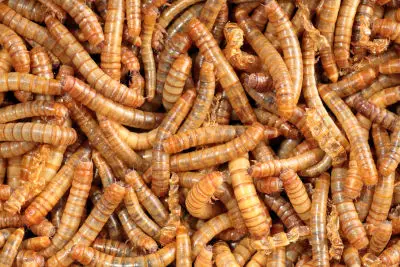How Smart is a Bearded Dragon? (This Might Surprise You!)
Ever wondered how smart a bearded Dragon really is? Well, I did and decided to share my findings with you. You be surprised to see how smart these lizards really are (Click here to see why I love this Bearded Dragon Guide).
How Smart is a Bearded Dragon? Bearded Dragons are very smart and have excellent problem-solving skills. They can also learn by watching other bearded dragons, a mark of intelligence once thought to belong only to higher mammals.
| Are these foods dangerous for your Beardie? | |
| Avacado? Click here to learn, from this guide, if this food is dangerous |  |
| Superworms? Click here to learn, from this guide, if this food is dangerous |  |
So, now you know they are smart, but what studies have been done to prove this? Can they even recognize you as their owner, and is it even possible to train them? These are just some of the things I will reveal to you next.
What Studies Have been Done on Bearded Dragon Intelligence?
Researchers at the University of Lincoln in the United Kingdom conducted a study to determine whether a Bearded Dragon trained to open a door to reach a meal worm could teach other bearded dragons to open the door just by observation.
Seven untrained Bearded Dragons were placed in a enclosure with the trained dragon. After watching the trained dragon open the door with its claws and head, all of the untrained dragons were able to open the door too.
A control group of four untrained Bearded Dragons were unable to open the door. At one time, the ability to learn by observation was thought to belong only to humans and other higher mammals.
Can Bearded Dragons Recognize Their Owners?
Bearded Dragons recognize their owners by sight. Their emotional range is much narrower than that of humans however. Your Bearded Dragon knows you, but the emotions it feels are restricted to anger, fear, or pleasure.
So, while your Bearded Dragon definitely knows you and may experience pleasure when you are around, to say it loves you might be a step too far.
How Can You Train a Bearded Dragon?
In the wild, bearded dragons are naturally shy. If your Bearded Dragon has not been socialized at the pet store, the first thing you will want to do is get it used to you so it will not be afraid.
Start this process gradually. Work up to handling your dragon slowly. As a final step, you can work on hand-feeding your Bearded Dragon as it becomes comfortable with your touch and learns to trust you. Here are some basic steps:
- Spend lots of time around your Bearded Dragon. When you first bring your Bearded Dragon home, make sure its enclosure is placed so that it can see you go about your day. Let your dragon get used to you being in the room without touching or handling it.
- Let your Bearded Dragon roam in a closed room. Shut the door to a room where you hang out, and make sure there are no open windows. The room should be warm enough for the Bearded Dragon to be comfortable, and it should be just you and the Bearded Dragon in the room.Let it roam about for an hour or so, but watch for signs of stress. If your dragon darkens its beard or takes an aggressive posture, it is stressed and needs to go back into is enclosure to calm down. Repeat this step until your dragon can roam about a closed room without getting stressed.
- Pick up your Bearded Dragon. Once your dragon has become comfortable around you and can roam without getting stressed, you can try picking it up. Never reach behind the dragon, as this can startle it, and never pick it up by the tail, as that can injure it.Bearded Dragons do not have tails that detach and grow back, so never, ever pick it up by its tail. Instead scoop your hand under if from the front and support the trunk of its body with your hand. Move slowly and calmly.
- Calm your Bearded Dragon.Your Bearded Dragon may show signs of stress or try to bite you when you pick it up. If this happens, slowly stroke its back. This should help calm your Bearded Dragon and help to convince the animal that you are nothing to be feared.Getting to this step may take quite awhile, but if you are patient and persistent, your dragon will eventually let you handle it.
Once you have trained your Bearded Dragon to let you handle it, you can begin to hand feed it. This step will further strengthen the dragon’s sense of security and calm around you.
If your dragon continues to show stress when you handle it, you can put it back in its enclosure to calm down, but be careful about doing this too often. Putting the dragon back once you pick it up can train it that all it has to do is display stress to get you to return it to its enclosure.
You don’t want it to train you to put it back, you want it to learn that you won’t hurt it and can be trusted to hold it. You probably won’t be able to teach your Bearded Dragon to do tricks, but you never know! Whatever you decide about training, you will have to start with basic socializing and handling.
Are Bearded Dragons Nocturnal?
Bearded Dragons (Click here to see if Green Beardies really exist) are one of the few reptiles that are not nocturnal. Instead, they are active during the day, making them ideal pets for reptile lovers, fun to watch and fun to train and handle.
Enjoy Your Bearded Dragon
Learning how to care for your dragon is complex and takes a lot of practice, a bit of intuition, and a good relationship with an experienced vet. People who get the hang of it become very attached to their dragons and no wonder!
A happy Bearded Dragon can provide years of companionship and entertainment. As long-lived as a dog or cat, Bearded Dragons truly deserve their magical name.
Related Questions:
How Much Care Do Bearded Dragons Need? Bearded Dragons are not like other reptiles. They require a very specific environment and feeding schedule and need regular vet visits with a doctor who knows about their habits and habitat.
Bearded Dragons need 12-14 hours of UV light every day. You will need a UV Light and a basking light. The basking temperature should be 95 F. for grown dragons and 110 F. for baby dragons.
The tank for your dragon will need to be at least 40 gallons (32 x 36 inches). A Bearded Dragon can grow to be 24 inches in length, so it needs some room. Place 2 to 3 inches of sand in the bottom, or use reptile carpet. Remove waste daily. Once a week, change out the sand completely.
Place a rock or branch under the basking light so your Bearded Dragon has something to hide behind and something to sit on and bask. Do not use heated rocks. They can burn your Bearded Dragon’s skin quickly.
You will also need to place a screen on top of your dragon enclosure. Believe it or not, Bearded Dragons can be clever escape artists!
Dragons are finicky about temperature and humidity. You will need a thermometer to monitor the temperature and a hygrometer to measure humidity. Dragons do best at 20% to 30% humidity, like the desert environment of their Australian home.
The basking end of your tank should be 95 to 110 degrees F, and the cool end between 75 and 85 F. At night you can drop the cool end down to between 65 and 75 degrees F.
If all that sounds complex, it’s because it is. Getting the environment just right is the key to making sure your Bearded Dragon thrives.
What Do I Feed My Bearded Dragon? Bearded Dragons are omnivorous, which means they eat both meat and fruits and vegetables. An adult Bearded Dragon will enjoy a diet of about 25% – 50% chopped greens, carrots, and yams, and a small amount (about 5%) of fresh fruit. Provide the chopped veggies every other day and the fruit once per week.
You can give the dragon a serving of commercial pellets every day, and supplement that with daily feedings of crickets, meal worms, or wax worms. Dust the food with calcium powder once per week.
Dragons need fresh water at all times. Sometimes they might not seem to be drinking. If that seems to be the case, you can spritz them with a bit of water mist from a spray bottle about twice per week.
How Do I Know If My Bearded Dragon Is Doing Well? A Bearded Dragon can live up to twelve years, so taking one home is a big responsibility and a big commitment. They make wonderful pets, but they are not the easiest reptile to take on, and advice that works for other reptiles usually won’t work for Bearded Dragons.
If you notice any of the following signs, your Bearded Dragon needs a visit to the vet:
- Skin discoloration or flaking.
- Swollen joints.
- Refusing food or water, excessive hiding.
- Discharge from the nose or eyes.
- Runny feces for more than a day or two.
Remember than healthy reptiles carry bacteria, viruses, parasites, and fungi that cause disease in humans, most especially salmonella, which can make you quite ill. This means you must wash your hands thoroughly before and after handling your Bearded Dragon, scooping its debris, or feeding it. Keep your hands away from your mouth and nose.